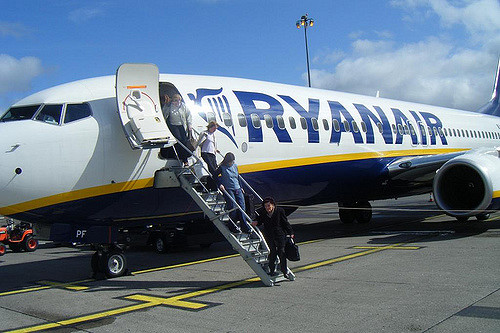
David Precious
Irish low-cost airline Ryanair has overtaken Lufthansa group by number of passengers transported in 2016. Lufthansa group, which also includes carriers Austrian Airlines, Swiss and low-cost airline Eurowings, last year increased transportation of passengers by 1.8%, to 109.7 million passengers, compared with 2015. Ryanair’s indices, on the other hand, rose by 15% to 117 million people. Thus, Ryanair became Europe's largest airline by passenger volume.
According to the International Civil Aviation Organization (ICAO), in 2016 total number of passengers carried by regular flights increased by 6% and reached 3.7 billion people. Ryanair’s share in total world passenger traffic was 3.2%.
Demand for budget air carrier services continues to increase. According to the ICAO’s data, in 2016 the share of low-cost carriers accounted for approximately 28% of total world scheduled passenger traffic.
A.T. Kearney consulting company estimated that share of budget airlines in the airline industry was 10% in 2003.
Number of transported in 2016 crossed the milestone of 1 billion people. Low-cost airlines took 32% of passenger traffic in Europe, 31% - in the Asia-Pacific region, 25% - in North America.
All the major European market participants showed growth of passenger traffic. So, Norwegian Air Shuttle Norwegian reported increase in passenger traffic by 14%, to 29 million people, Polish Wizz Air grew transportation by 19% to 22.7% million, French EasyJet - by 6.6%, to 74.5 million people.
In response to the growing competition, traditional airlines are expanding their tariff scale and are introducing low rates, nearly equal to offers of low-cost airlines.
Thus, British Airways has canceled free meals in economy class on short flights from London airports Heathrow and Gatwick. Now, food can be purchased for an additional fee. In 2017, the American United Airlines plans to introduce a new "super-economy" fare, which is essentially a trip without free baggage transportation.
Average width of seatway (according to US statistics) has been narrowed from 88.9 cm 70 years ago to 78.74 cm in 2015. Width of economy class seats has also been reduced from 45.72 cm to 41.91 cm.
"Many passengers are willing to give up free food and drinks for a reasonable price for domestic flights or short-range flights", - said president of consulting firm Strategic Aviation Solutions Neil Hansford.
On the other hand, long-haul flights remain a tough nut to crack to low-cost carriers. The more time an aircraft spends in the air, the less opportunity for savings the airline has, and the more is a risk that the crew will have to stay overnight at a hotel. Also, Boeing 737 and Airbus A320, loved by many discounters, usually do not fly more than 5 thousand. km, which means that longer flights need to be performed by wide-bodied aircraft. They consume more fuel and are more difficult to pack with passengers.
source: bloomberg.com, dw.de
According to the International Civil Aviation Organization (ICAO), in 2016 total number of passengers carried by regular flights increased by 6% and reached 3.7 billion people. Ryanair’s share in total world passenger traffic was 3.2%.
Demand for budget air carrier services continues to increase. According to the ICAO’s data, in 2016 the share of low-cost carriers accounted for approximately 28% of total world scheduled passenger traffic.
A.T. Kearney consulting company estimated that share of budget airlines in the airline industry was 10% in 2003.
Number of transported in 2016 crossed the milestone of 1 billion people. Low-cost airlines took 32% of passenger traffic in Europe, 31% - in the Asia-Pacific region, 25% - in North America.
All the major European market participants showed growth of passenger traffic. So, Norwegian Air Shuttle Norwegian reported increase in passenger traffic by 14%, to 29 million people, Polish Wizz Air grew transportation by 19% to 22.7% million, French EasyJet - by 6.6%, to 74.5 million people.
In response to the growing competition, traditional airlines are expanding their tariff scale and are introducing low rates, nearly equal to offers of low-cost airlines.
Thus, British Airways has canceled free meals in economy class on short flights from London airports Heathrow and Gatwick. Now, food can be purchased for an additional fee. In 2017, the American United Airlines plans to introduce a new "super-economy" fare, which is essentially a trip without free baggage transportation.
Average width of seatway (according to US statistics) has been narrowed from 88.9 cm 70 years ago to 78.74 cm in 2015. Width of economy class seats has also been reduced from 45.72 cm to 41.91 cm.
"Many passengers are willing to give up free food and drinks for a reasonable price for domestic flights or short-range flights", - said president of consulting firm Strategic Aviation Solutions Neil Hansford.
On the other hand, long-haul flights remain a tough nut to crack to low-cost carriers. The more time an aircraft spends in the air, the less opportunity for savings the airline has, and the more is a risk that the crew will have to stay overnight at a hotel. Also, Boeing 737 and Airbus A320, loved by many discounters, usually do not fly more than 5 thousand. km, which means that longer flights need to be performed by wide-bodied aircraft. They consume more fuel and are more difficult to pack with passengers.
source: bloomberg.com, dw.de





